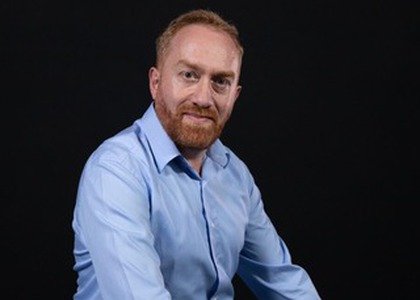> Interviews

Interview with director Erwin Șimșensohn
Mr. Șimșensohn, how did you approach the staging of the opera,considering it is structured into 66 scenes? I noticed it also has a large number of characters, based on the cast list. How did you handle the fragmentation of the narrative while maintaining coherence and audience engagement throughout the performance?
It was a significant challenge and a major stake, also due tothe dramatic structure - as you mentioned, there are 66 scenes. We managed to sightly compress the structure of the work - of course, with the permission of the dramaturg and especially the composer -since it was originally much denser. And would have resulted in an extremely long performance. We've shortened the piece a bit.
It does not follow the structure of a classical opera, as certain fragments are sung in Romanian, but it is a combination of opera and theater sequences. In some of the theatrical sequences, the orchestra plays; therefore, there are pieces specifically composed for orchestrating the theater scenes in which we involved actors. There are also theater scenes without musical orchestration in our proposed version. So, essentially, it is a story that we have tried to make as easy to follow as possible.
It is, of course, based on the real case of Adolf Eichmann, the trail from 1960-1961, ended with his execution in early 1962. The opera follows, in fact, the trial-where the main roles are played by the prosecutor, the lawyers, the defendant, and the judge. In addition to these, the key moments are represented by the testimonies of those brought in to testify and recount the events they experienced during the Holocaust
It can be followed. It is impressive. It doesn't have a narrative thread in the classical sense, where a story is introduced, something happens, a plot with a beginning, development and conclusion unfolds. It is, in fact, a pursuit, a revisiting of a historical period, an extremely powerful and sad period, and it's something I believe needs to be discussed.
I know that many raised an eyebrow, including colleagues and acquaintances… "How can you create an opera, how can you sing about such a theme?" It seems almost impossible to compose a musical piece on such a harsh, profound subject. Nevertheless, we actually tried to use the medium of music, the medium of theater, these artistic means precisely to speak about real events, to talk about a drama, about a tragedy not only of the Jewish people but of all humanity.
As for the staging, the set, what are some aspects that you wanted to highlight and how do you collaborate with scenographer Dragoș Buhagiar to achieve this?
First and foremost,it was, and still is, a great honor for me to collaborate with Dragoș Buhagiar, a scenographer with remarkable experience and an outstanding body of work behind him. He is one of the most highly regarded scenographer in Romania. It was a joy! Beyond his creativity, his energy and the fact that he is extremely focused made it possible for things to come together in an absolutely record time. And together, we found solutions to highlight exactly what we were aiming for.
As the central element of the production's scenography, we maintain the courtroom with everything it entails-judges, prosecutors, lawyers, the defendant, and the audience, which, in this case, is represented by the Choir of the Bucharest National Opera. This serves as the focal point of the scenography, but from it, various other spaces emerge, such as the office of the Bonn chancellor, the office of the Israeli prime minister's representative, the lawyers' office, and the meeting room. However, all of these are essentially small cutouts of the central scenographic element. Here, video design by Andrei Cozlac and lighting design by Daniel Klinger play a crucial role. Both visuals and lighting are essential not only in delivering the story but also in segmenting these different scenic spaces.
As far as I can imagine, since we're talking about a world premiere of an opera, the main character on trial, Adolf Eichmann, is portrayed in this production by baritone Alexandru Constantin. Will he be present on stage for most of the time? How long does the opera last?
The performance will last around three hours, a little over three including an intermission. But, importantly, many of the roles-since this is a blend of opera and theater scenes-are actually doubled by both singers and actors. Essentially, there are two performers for the same role. Eichmann's role is performed by baritone Alexandru Constantin in the musical scenes, the arias, and duets, while in the theater scenes, the role is played by actor Marian Râlea. Similarly, the role of prosecutor Hausner is portrayed by soloist Iustinian Zetea, as well as actor Emilian Oprea. Several roles follow this doubling approach. The cast includes many notable actors and prominent soloists from the Bucharest National Opera.
That's wonderful! So, can we see it as a tool for historical education?
We didn't set out to create a historical education tool, but we would be very happy if it became one and served that purpose.
Photo: The State Theater Constanța
Translated by Adina Gabriela Văcărelu,
University of Bucharest, Faculty of Foreign Languages and Literatures, MTTLC, year I
Corrected by Silvia Petrescu














